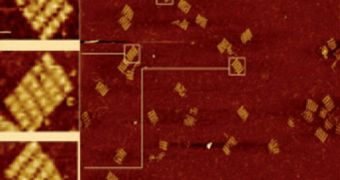Researchers know that one of the keys that would allow for the widespread use of nanotechnology, and for the production of complex nanostructures would be the creation of large-scale DNA origami. These constructs can tie nanostructures together in intricate patterns, based on chemical attraction between its four base pairs. Now, experts in the United States, have taken the first steps towards making this a reality, with the creation of a process that allows for the large-scale production of DNA origami.
“One of the practical limitations of DNA origami has been the size. We have been limited to 2D structures roughly 100 [nanometers] in size, due to the length of the scaffold strand that is used. The reason for this is because it is difficult to get long single-stranded scaffolds longer than around 7000-8000 nucleotides, inexpensively and in high yield,” Paul Rothemund, the California Institute of Technology (Caltech) researcher that originally created these structures, told Chemistry World. He explained that a technique known as Watson-Crick base pairing was used to fold long strands of viral DNA in complex patterns, via the action of small chunks of 'helper DNA.' This substance acted like a catalyst, he went on to say.
Depending on which configuration pattern is inscribed in the helper DNA, the long, viral strands can basically be woven back and forth, creating whatever type of patterns is needed. Now, a team of investigators at the Arizona State University (ASU), led by experts Hao Yan and Yan Liu, managed to make an improved production process that is able to create strands four times longer than the ones possible using the technique Rothemund developed. Instead of using helper DNA to pin the viral strands of genetic material together, the ASU team used DNA origami shaped like squares to do the same. This allowed for the creation of large structures, 5x5 to 7x8 arrangements of tiles, reaching up to 200 nanometers in size, a record.
“Whatever size we can achieve with the basic technique, Yan and Liu's technique seems likely to buy us an extra factor of scale. Importantly, this increase in size should bring us into the range of state of the art optical lithography, which will allow us to start enabling the use of this process,” the Caltech expert said of his colleagues' achievement. “I think this is a terrific idea, and I'm confident that such a hierarchical templating approach will play a key role in allowing us to build increasingly complex devices on the nanoscale. One application might possibly be a nano-breadboard for assembling nanoscale circuits,” Harvard University DNA origami expert William Shih added.

 14 DAY TRIAL //
14 DAY TRIAL //